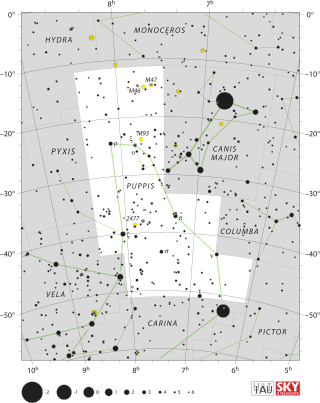
A Bayer designation is a stellar designation in which a specific star is identified by a Greek or Latin letter followed by the genitive form of its parent constellation's Latin name. The original list of Bayer designations contained 1,564 stars. The brighter stars were assigned their first systematic names by the German astronomer Johann Bayer in 1603, in his star atlas Uranometria. Bayer catalogued only a few stars too far south to be seen from Germany, but later astronomers supplemented Bayer's catalog with entries for southern constellations.
In astronomy, a variable-star designation is a unique identifier given to variable stars. It uses a variation on the Bayer designation format, with an identifying label preceding the Latin genitive of the name of the constellation in which the star lies. See List of constellations for a list of constellations and the genitive forms of their names. The identifying label can be one or two Latin letters or a V plus a number. Examples are R Coronae Borealis, YZ Ceti, V603 Aquilae.

Pi Puppis, Latinized from π Puppis, also named Ahadi, is the second-brightest star in the southern constellation of Puppis. It has an apparent visual magnitude of 2.733, so it can be viewed with the naked eye at night. Parallax measurements yield an estimated distance of roughly 810 light-years from the Earth. This is a double star with a magnitude 6.86 companion at an angular separation of 0.72 arcsecond and a position angle of 148° from the brighter primary.

L2 Puppis (also known as HD 56096) is a giant star in the constellation of Puppis and is located between the bright stars Canopus and Sirius. It is a semi-regular pulsating star.

k Puppis is a Bayer designation given to an optical double star in the constellation Puppis, the two components being k1 Puppis and k2 Puppis.

Collinder 135, known sometimes as the Pi Puppis Cluster, is an open cluster in Puppis constellation.

Rho Puppis, formally named Tureis, is a star in the southern constellation of Puppis. With an average apparent visual magnitude of 2.78, it is the third-brightest member of this generally faint constellation. Based upon parallax measurements made during the Hipparcos mission, Rho Puppis is located at a distance of 63.5 light-years from the Sun. It is the prototype of the ρ Puppis class of evolved Am stars.

Omicron Puppis (ο Puppis) is candidate binary star system in the southern constellation of Puppis. It is visible to the naked eye, having a combined apparent visual magnitude of +4.48. Based upon an annual parallax shift of 2.30 mas as seen from Earth, it is located roughly 1,400 light years from the Sun.
The Bayer designations j Puppis and J Puppis are distinct. Due to technical limitations, both designations link here. For the star
The Bayer designations q Puppis and Q Puppis are distinct. Due to technical limitations, both designations link here. For the star
The Bayer designations p Puppis and P Puppis are distinct. Due to technical limitations, both designations link here. For the star
The Bayer designation L Puppis is shared by two stars in the constellation Puppis:
The Bayer designation υ Puppis is shared by two stars in the constellation Puppis:
The Bayer designations h Puppis and H Puppis are distinct. They can refer to three stars in the constellation Puppis:
The Bayer designations c Puppis and C Puppis are distinct and refer to two different stars in the constellation Puppis:
The Bayer designations m Puppis and M Puppis are distinct. Due to technical limitations, both designations link here. For the star
The Bayer designations D Puppis and d Puppis are distinct.
For D Puppis:
The Bayer designations T Puppis and t Puppis are distinct and refer to two different stars in the constellation Puppis:
The Bayer designations Y Puppis and y Puppis are distinct and refer to many different stars in the constellation Puppis:
For Y Puppis:
The Bayer designations X Puppis and x Puppis are distinct and refer to three different stars in the constellation Puppis:
This page is based on this
Wikipedia article Text is available under the
CC BY-SA 4.0 license; additional terms may apply.
Images, videos and audio are available under their respective licenses.



